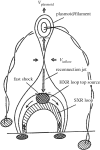The source and engine of coronal mass ejections
- PMID: 31079580
- PMCID: PMC6527956
- DOI: 10.1098/rsta.2018.0094
The source and engine of coronal mass ejections
Abstract
Coronal mass ejections (CMEs) are large-scale expulsions of coronal plasma and magnetic field propagating through the heliosphere. Because CMEs are observed by white-light coronagraphs which, by design, occult the solar disc, supporting disc observations (e.g. in EUV, soft X-rays, Halpha and radio) must be employed for the study of their source regions and early development phases. We review the key properties of CME sources and highlight a certain causal sequence of effects that may occur whenever a strong (flux-massive and sheared) magnetic polarity inversion line develops in the coronal base of eruptive active regions (ARs). Storing non-potential magnetic energy and helicity in a much more efficient way than ARs lacking strong polarity inversion lines, eruptive regions engage in an irreversible course, making eruptions inevitable and triggered when certain thresholds of free energy and helicity are crossed. This evolution favours the formation of pre-eruption magnetic flux ropes. We describe the steps of this plausible path to sketch a picture of the pre-eruptive phase of CMEs that may apply to most events, particularly the ones populating the high end of the energy/helicity distribution, that also tend to have the strongest space-weather implications. This article is part of the theme issue 'Solar eruptions and their space weather impact'.
Keywords: coronal mass ejections; interpretation; solar eruptions.
Conflict of interest statement
We declare we have no competing interests.
Figures








References
-
- Webb DF, Howard TA. 2012. Coronal mass ejections: observations. Living Rev. Solar Phys. 9, 3 ( 10.12942/lrsp-2012-3) - DOI
-
- Fletcher L. et al. 2011. An observational overview of solar flares. Space Sci. Rev. 159, 19–106. ( 10.1007/s11214-010-9701-8) - DOI
-
- Andrews MD. 2003. A search for CMEs associated with big flares. Solar Phys. 218, 261–279. ( 10.1023/B:SOLA.0000013039.69550.bf) - DOI
-
- Yashiro S, Gopalswamy N, Akiyama S, Michalek G, Howard RA. 2005. Visibility of coronal mass ejections as a function of flare location and intensity. J. Geophys. Res. (Space) 110, A12S05 ( 10.1029/2005JA011151) - DOI
-
- Hudson HS, Cliver EW. 2001. Observing coronal mass ejections without coronagraphs. J. Geophys. Res. (Space) 106, 25199–25214. ( 10.1029/2000JA904026) - DOI
LinkOut - more resources
Full Text Sources

